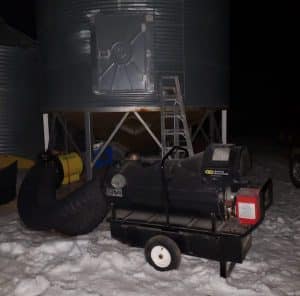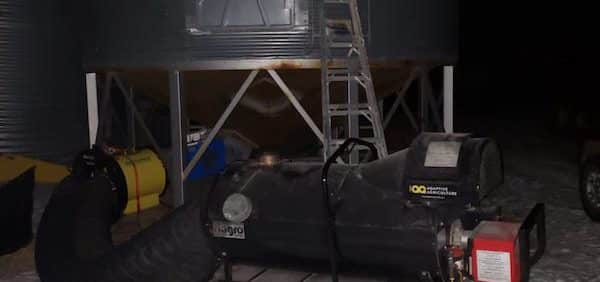Stored canola with moisture content higher than 8% will be at higher risk of spoilage as temperatures warm up this spring. Farmers with high-moisture canola will need a plan to protect that canola.
“There is a lot of high-moisture canola on farms this spring and most of it will have to be managed before delivery,” says Angela Brackenreed, agronomy specialist with the Canola Council of Canada. She says farmers probably shouldn’t rely on being able to deliver high-moisture canola to elevators in time to reduce the risk.
“This is a real challenge, which is why we’re talking about it now,” Brackenreed says. “With the sun now packing more heat, high-moisture canola could become volatile in the bin.”
Step one is to check all bins. A recent PAMI research project showed that dry canola stored into the summer is probably best left alone, but this same recommendation does not extend to moist canola. Take out a load from each bin and feel for heat and check for damage.
Step two is to look at on-farm infrastructure to keep that canola safe. “Put it through the dryer if you have access to one, or add supplemental heat to the aeration system and get the canola dried,” Brackenreed says.
For supplemental heat, propane- or diesel-powered heaters (see the photo) added to the aeration system provide a fairly simple way to improve the drying capacity of air. Warm air with lower relative humidity (RH) has more capacity to dry.

Once outside air is consistently above 0°C for extended hours each day, use the supplemental heaters to bring incoming air to at least 15-20°C. For every 10°C increase in air temperature, the RH is cut in half – which increases the air’s capacity to hold (and therefore remove) moisture. Joy Agnew, a grain storage researcher, says “air at 18°C will dry five times faster than air at 10°C.”
Note that warm air isn’t enough for effective drying. “The fan also has to provide enough airflow to push that warm air fairly quickly through grain and out the top of the bin,” Brackenreed says.
Airflow rates needs to be at least 1.0 cubic feet per minute per bushel (cfm/bu.) for moisture removal. Wilde Ag Ventures sells gauges to read airflow in the plenum between fan and bin. Without these, you can estimate static pressure and check airflow based on charts specific to each fan model to determine the approximate cfm/bu being achieved. The key is that canola, being a small-seeded crop, has more resistance to airflow. Canola therefore requires greater airflow rates with fans that can operate at fairly high static pressure to push air and move the drying front efficiently through the mass. Farmers can get a sense of airflow by feeling for moist air flowing out the bin vents. For improved airflow, reduce the depth of canola in the bin.
“Don’t underestimate the value of removing grain to improve airflow. It could reduce drying time by least half,” Brackenreed says.
Natural air drying almost useless (this time of year)
If turning on the aeration fans to dry canola without any supplemental heat, note the potential risk of trying this too early in the season. “This time of year, most days are poor drying days – which is when RH is 70 per cent or more or the temperature is 10°C or less,” Brackenreed says. “Even if the daytime high reaches 10°C, how many hours is it actually at that temperature?”
So if you’re not drying, then what are you doing? “When air is not warm enough to actually do any drying, then you’re just warming up the bulk enough to give a head start to the microbial processes that lead to spoilage,” Brackenreed says.
Other considerations
Make sure to have good ventilation at the top of the bin to allow warm, moist air to escape. Inadequate ventilation in the headspace will result in condensation on the top layers of grain. “Condensation and ice build up at the inside top of the bin is a good sign of poor ventilation,” Brackenreed says. “Add more vents or active ventilation, or consider even a small fan at the top of the bin to suck out the moist air.”
For effective drying using supplemental heat, the bin needs to be turned frequently – every day to every few days. Without turning, it will take substantial time for the drying front to reach the top layers of the bin.
And finally, just because a bin-and-fan set up is new doesn’t mean it’s better. “New bigger bin set ups could have less adequate airflow than smaller older set ups,” Brackenreed says.

